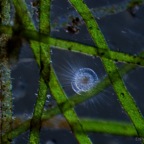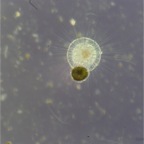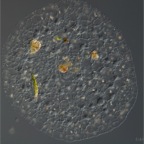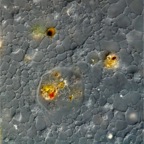WunderkanoneExploring the Microscopic World
Actinospaerium eichhornie
Actinosphaerium eichhornie (Ehrenberg, 1840) is the largest of the Heliozoans, reaching the diameter of a pinhead (200-300µm). There is a variation that can even reach 1 mm. Actinosphaerium is the only Heliozoan with multiple nuclei (the actual number depends on the size of the individual species) and is a planktic species living between aquatic plants, where it floats and waits patiently for prey. Actinosphaerium is a fierce predator that can catch and engulf algae, larger cilates and even rotifers.
When prey comes in contact with the axopodia (the rays) it is immediately immobilized. A food vacuole is constructed around the captured prey. When the food vacuole is complete, the axopodia are retracted and the prey is drawn into the body of the Heliozoan. Actinospaerium has a big central food vacuole which seems to be the preferred place for phagocytosis. Building the food vacuole takes up to 10 minutes, the entire phagocytosis around 30 minutes. When living conditions get bad, Actinospaerium can build a cyst to wait for better times.






